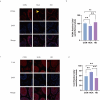Sodium butyrate promotes synthesis of testosterone and meiosis of hyperuricemic male mice
- PMID: 40295597
- PMCID: PMC12037722
- DOI: 10.1038/s41598-025-95846-6
Sodium butyrate promotes synthesis of testosterone and meiosis of hyperuricemic male mice
Abstract
Hyperuricemia (HUA) impaires spermatogenesis. This study was carried out, aiming to determine whether butyric acid (NaB) avoids the HUA-induced decline of sperm quality HUA mice were developed through intra-peritoneal injection of the potassium oxalate combined with intragastric uric acid (UA) and by tube feeding 300 mg·kg-1·d-1NaB. The effect of NaB on the reproduction of HUA male mice was determined by measuring sperm count, sperm motility and testosterone content. In addition, TM3 and GC-2 cells were treated with a solution containing 30 mg/dl UA and 1mM NaB. The effects of NaB on the sperm quality were evaluated with the expression level of the genes involving in LH/cAMP/PKA signaling pathway and meiosis, and that encoding OPRL1 receptor protein. Results showed that NaB improved sperm count, sperm motility, testosterone synthesis, and impaired spermatocyte meiosis via HUA. In addition, in vitro analysis showed that NaB activated the LH/cAMP/PKA signaling pathway of TM3 cells, promoted the synthesis of testosterone, up-regulated the content of pain-sensitive peptide receptor (OPRL1) on the surface of GC-2 cells, and promoted meiosis. NaB also promoted the utilization of ATP by GC-2 cells. We illustrated a close relationship between HUA and spermatogenesis defects. NaB-promoted the expression of the genes functioning in testis meiosis, and the testosterone content may aid to improving spermatogenesis quality.
Keywords: Hyperuricemia; Meiosis; Sodium butyrate; Sperm quality; Testosterone.
© 2025. The Author(s).
Conflict of interest statement
Declarations. Competing interests: The authors declare no competing interests. Ethics statement: Animal research was approved by the Affiliated Hospital of Qingdao University (Approval code: AHQU-MAL20230322) and was performed in line with the principles of the Declaration of Helsinki.
Figures






Similar articles
-
Protective effect of sodium butyrate on intestinal barrier damage and uric acid reduction in hyperuricemia mice.Biomed Pharmacother. 2023 May;161:114568. doi: 10.1016/j.biopha.2023.114568. Epub 2023 Mar 20. Biomed Pharmacother. 2023. PMID: 36948133
-
Letrozole protects against cadmium-induced inhibition of spermatogenesis via LHCGR and Hsd3b6 to activate testosterone synthesis in mice.Reprod Biol Endocrinol. 2022 Mar 2;20(1):43. doi: 10.1186/s12958-022-00915-4. Reprod Biol Endocrinol. 2022. PMID: 35236366 Free PMC article.
-
Reduced testosterone and Ddx3y expression caused by long-term exposure to arsenic and its effect on spermatogenesis in mice.Environ Toxicol Pharmacol. 2018 Oct;63:84-91. doi: 10.1016/j.etap.2018.08.012. Epub 2018 Aug 18. Environ Toxicol Pharmacol. 2018. PMID: 30189373
-
The anti-oxidant effects of ginger and cinnamon on spermatogenesis dys-function of diabetes rats.Afr J Tradit Complement Altern Med. 2014 Jun 4;11(4):1-8. doi: 10.4314/ajtcam.v11i4.1. eCollection 2014. Afr J Tradit Complement Altern Med. 2014. PMID: 25392573 Free PMC article.
-
Contraceptive efficacy: Determining the threshold for effective suppression based on sperm concentration, motility, and morphology.Andrology. 2024 Oct;12(7):1574-1584. doi: 10.1111/andr.13701. Epub 2024 Jul 19. Andrology. 2024. PMID: 39031534 Review.
Cited by
-
The Androbactome and the Gut Microbiota-Testis Axis: A Narrative Review of Emerging Insights into Male Fertility.Int J Mol Sci. 2025 Jun 27;26(13):6211. doi: 10.3390/ijms26136211. Int J Mol Sci. 2025. PMID: 40649988 Free PMC article. Review.
References
-
- Carrageta, D. F. et al. Signatures of metabolic diseases on spermatogenesis and testicular metabolism. Nat. Rev. Urol.21, 477–494 (2024). - PubMed
MeSH terms
Substances
Grants and funding
- 81671625 and 81100554/National Natural Science Foundation of China
- 81671625 and 81100554/National Natural Science Foundation of China
- 81671625 and 81100554/National Natural Science Foundation of China
- 81671625 and 81100554/National Natural Science Foundation of China
- 81671625 and 81100554/National Natural Science Foundation of China
- 81671625 and 81100554/National Natural Science Foundation of China
- 81671625 and 81100554/National Natural Science Foundation of China
- 81671625 and 81100554/National Natural Science Foundation of China
- 81671625 and 81100554/National Natural Science Foundation of China
- 81671625 and 81100554/National Natural Science Foundation of China
- 81671625 and 81100554/National Natural Science Foundation of China
- BS2012YY003/Young and Middle-Aged Scientists Research Awards Fund of Shandong Province
- BS2012YY003/Young and Middle-Aged Scientists Research Awards Fund of Shandong Province
- BS2012YY003/Young and Middle-Aged Scientists Research Awards Fund of Shandong Province
- BS2012YY003/Young and Middle-Aged Scientists Research Awards Fund of Shandong Province
- BS2012YY003/Young and Middle-Aged Scientists Research Awards Fund of Shandong Province
- BS2012YY003/Young and Middle-Aged Scientists Research Awards Fund of Shandong Province
- BS2012YY003/Young and Middle-Aged Scientists Research Awards Fund of Shandong Province
- BS2012YY003/Young and Middle-Aged Scientists Research Awards Fund of Shandong Province
- BS2012YY003/Young and Middle-Aged Scientists Research Awards Fund of Shandong Province
- BS2012YY003/Young and Middle-Aged Scientists Research Awards Fund of Shandong Province
- BS2012YY003/Young and Middle-Aged Scientists Research Awards Fund of Shandong Province
- 2011QZ007 and 2016WS0259/Scientific and Technical Development Project of the Department of Health of Shandong Province
- 2011QZ007 and 2016WS0259/Scientific and Technical Development Project of the Department of Health of Shandong Province
- 2011QZ007 and 2016WS0259/Scientific and Technical Development Project of the Department of Health of Shandong Province
- 2011QZ007 and 2016WS0259/Scientific and Technical Development Project of the Department of Health of Shandong Province
- 2011QZ007 and 2016WS0259/Scientific and Technical Development Project of the Department of Health of Shandong Province
- 2011QZ007 and 2016WS0259/Scientific and Technical Development Project of the Department of Health of Shandong Province
- 2011QZ007 and 2016WS0259/Scientific and Technical Development Project of the Department of Health of Shandong Province
- 2011QZ007 and 2016WS0259/Scientific and Technical Development Project of the Department of Health of Shandong Province
- 2011QZ007 and 2016WS0259/Scientific and Technical Development Project of the Department of Health of Shandong Province
- 2011QZ007 and 2016WS0259/Scientific and Technical Development Project of the Department of Health of Shandong Province
- 2011QZ007 and 2016WS0259/Scientific and Technical Development Project of the Department of Health of Shandong Province
LinkOut - more resources
Full Text Sources
Miscellaneous

